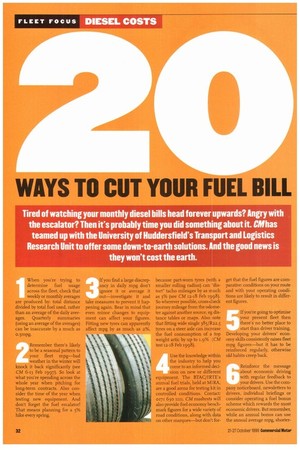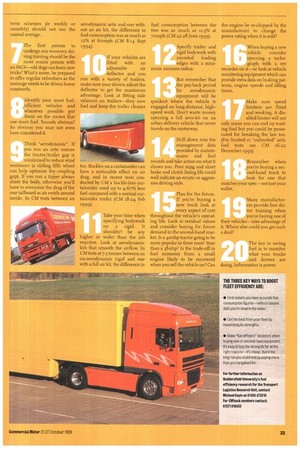AYSWOUR FUEL BILL
Page 34

Page 35

If you've noticed an error in this article please click here to report it so we can fix it.
Tired of watching your monthly diesel bills head forever upwards? Angry with the escalator? Then it's probably time you did something about it. Mims teamed up with the University of Huddersfield's Transport and Logistics Research Unit to offer some down-to-earth solutions. And the good news is they won't cost the earth.
When you're trying to determine fuel usage across the fleet, check that weekly or monthly averages re produced by: total distance divided by total fuel used, rather than an average of the daily averages. Quarterly summaries (using an average of the averages) can be inaccurate by a much as o.5rripg.
Remember there's likely . to be a seasonal pattern to
ur fleet mpg—bad eather in the winter will knock it back significantly (see CM 6-13 Feb 1997). So look at what you're spending across the whole year when pitching for long-term contracts. Also consider the time of the year when testing new equipment. And don't forget the fuel escalator! at means planning for a 5% e every spring. If you find a large discrep ancy in daily mpg don't ignore it or average it
out—investigate it and take measures to prevent it happening again. Bear in mind that even minor changes to equipment can affect your figures. Fitting new tyres can apparently affect mpg by as much as 2%, because part-worn tyres (with a smaller rolling radius) can "distort" tacho mileages by as much as 3% (see CM 12-18 Feb 1998). So wherever possible, cross-check journey mileage from the odometer against another source, eg distance tables or maps. Also note that fitting wide single 385/R22.5 tyres on a steer axle can increase the fuel consumption of a top weight attic by up to 1.9% CM test 12-18 Feb 1998).
Use the knowledge within the industry to help you come to an informed decision on new or different equipment, The BTAC/IRTE's annual fuel trials, held at MI RA, are a good arena for testing kit in controlled conditions. Contact: 0171 630 mi. CM roadtests will also provide fuel economy benchmark figures for a wide variety of road conditions, along with data on other marques—but don't for get that the fuel figure§ are comparative: conditions on your route and with your operating conditions are likely to result in different figures.
If you're going to optimise your present fleet then there's no better place to start than driver training.
Developing your drivers' economy skills consistently raises fleet mpg figures—but it has to be reinforced regularly, otherwise old habits creep back.
Reinforce the message about economic driving with regular feedback to your drivers. Use the com pany noticeboard, newsletters to drivers, individual briefings or consider operating a fuel bonus scheme which rewards the most economic drivers. But remember, while an annual bonus can use the annual average mpg, shorter
term schemes (ie weekly or monthly) should not use the annual average.
The first person to undergo any economy driving training should be the most senior person with an HGV—old dogs can learn new tricks! What's more, be prepared to offer regular refreshers as the message needs to be driven home constantly.
Identify your most fuelefficient vehicles and wherever possible put them on the routes that use most fuel. Sounds obvious?
So obvious you may not even have considered it.
Think "aerodynamic". If you run an artic ensure the tractor/trailer gap is minimised to reduce wind
resistance (a sliding fifth wheel can help optimise the coupling gap). If you run a tipper always sheet the body, otherwise you'll have to overcome the drag of the rear tailboard as air swirls around inside. In CM tests between an aerodynamic attic and one without an air kit, the difference in fuel consumption was as much as 12% at 6o mph (CM 844 Sept 1994) If your vehicles are fitted with an adjustable air deflector and you run with a variety of trailers, make sure your drivers adjust the deflector to get the maximum advantage. Look at fitting side valances on trailers—they save fuel and keep the trailer cleaner too. Buckles on a curtainsider can have a noticeable effect on air drag, and in recent tests conducted by CM a buckle-less curtainsider used up to 4.67% less fuel compared with a normal curtainsider trailer (CM 18-24 Feb 1999) Take your time when specifying bodywork on a rigid. It shouldn't be any higher or wider than the job requires. Look at aerodynamic kits that smooth the airflow. In CM tests at 7.5 tonnes between an un-aerodynamic rigid and one with a full air kit, the difference in fuel consumption between the two was as much as 11.5% at 70mph (CM 22-28 June 1995).
Specify trailer and rigid bodywork with rounded leading edges with a minimum 200mm radius.
But remember that the pay-back period for aerodynamic equipment will be
quickest where the vehicle is engaged on long-distance, highspeed work. Don't waste money speccing a full aero-kit on an urban delivery vehicle that never travels on the motorway.
Drill down into the management data provided by maintenance and fuel records and take action on what it shows you. Poor mpg and short brake and clutch lining life could well indicate an erratic or aggressive driving style.
Plan for the future. If you're buying a new truck look at every aspect of cost throughout the vehicle's operating life. Look at residual values and consider buying for future demand in the second-hand market. Is a 400hp tractor going to be more popular in three years' time than a 38ohp? Is the trade-off in fuel economy from a small engine likely to be recovered when you sell the vehicle on? Can the engine be re-chipped by the manufacturer to change the power rating when it is sold?
When buying a new vehicle consider speccing a tachograph with a rev
recorder on it—or look at vehicle monitoring equipment which can provide extra data on braking patterns, engine speeds and idling times.
Make sure speed limiters are fitted and working. A disabled limiter will not
only mean you can end up wasting fuel but you could be prosecuted for breaking the law too. (For limited vs "unlimited" attic fuel tests see CM 1(6-22 December 1993).
Remember when you're buying a second-hand truck to look for one that
matches your spec—not just your wallet.
Many manufacturers provide free driver training when you're buying one of their vehicles—take advantage of it. Where else could you get such a deal?
The key to saving fuel is to monitor what your trucks and drivers are
doing. Information is power.
THE THREE KEY WAYS TO BOOST FLEET EFFICIENCY ARE:
• First ensure you have accurate fuel consumption figures—without decent data you're dead in the water.
• Get the best from your fleet by maximising its strengths.
• Make "fuel efficient" decisions when buying new or second-hand equipment. It's easy to buy the wrong kit for all the rght reasons—it's cheap. But in the long.run you could end up paying more than you bargained for.
For further information on Huddersfield University's fuel efficiency research for the Transport Logistics Research Unit, contact Michael Coyle on 01484 473210 For CM back numbers contact: 01371 810433












































































































